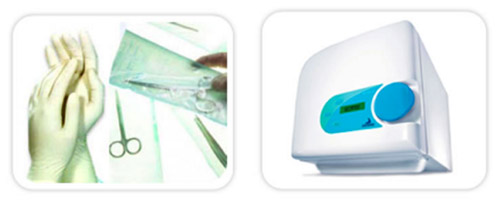STAY TUNNED
The set of actions aimed at preventing, minimizing or eliminating the risks inherent in production activities and services aimed at human health.
It is the responsibility of the dentist the orientation and maintenance of the aseptic chain by the dental team and compliance with the standards of quality and safety. As well as having a role in the production of health awareness in the community where it operates. Has importance in preserving the environment, when handles and disposes chemical, toxic and infectious waste. Leading to an overall reduction of health risks and accidents.

Root canal therapy involves removing the diseased or prosthetic needed dental pulp, modeling of the channel and filling the space formerly occupied by the pulp.
After endodontic treatment is completed, the tooth will need prosthesis to restore or return to its normal shape and function.
When endodontic treatment is done, the tooth became very fragile. In the event of delay or negligence on the part of the patient to rehabilitate the tooth restored with prosthesis, this may result in fractures or infect the channel again, resulting in the need for retreatment of the canal or even extraction of the tooth.
Dental caries can be defined as a localized destruction of dental tissues caused by the action of bacteria. The demineralization of dental tissues is caused by acids, especially lactic acid produced by bacterial fermentation of carbohydrates present in the diet, usually sucrose. The low pH causes the dissolution of the enamel and transport of calcium and phosphate to the oral environment. Dental caries is one of the most common dental diseases. Generally, results from an inadequate diet, poor oral hygiene and the consequent buildup of plaque.
The plaque is nothing more than the accumulation of live bacteria and food on the teeth. It is the main factor that causes the most common diseases in the oral cavity: caries and gum disease (gingivitis and periodontitis). When there isn’t a good brushing, plaque builds up and can infiltrate between the teeth and gums causing bleeding, redness and swelling, which are the main symptoms of gingivitis.
This infiltration can further extend and harden into tartar, which can only be mechanically removed by a dentist. Together plaque and tartar can aggravate gingivitis, tooth moving from the gum, thus compromising the bone structure (symptoms of periodontitis), which can cause tooth loss.
Brushing is not enough to keep the teeth free of bacterial action. The flossing is essential to remove plaque and food particles between teeth, places where a toothbrush can not reach. Return to the clinic every 6 months to review your oral health.
– Do not rinse your mouth vigorously (mouthwash) for the first 72 hours after surgery.
– Expel the air normally, when coughing or sneezing, never hold these involuntary stimuli, as there is a risk of serious postoperatively complications.
– Keep-liquid or soft diet during the first 2 days after surgery, and, preferably cold for the first 24 hours. Do not smoke or drink alcoholic beverages during the first week.
– Use an ice pack on the surgical area only in the first 48 hours, apply for 20 minutes a row, with 2 hours of rest. Use moisturizer on the skin especially when you are still anesthetized
– In the first 24 hours is common to appear bloodstains in saliva, do not worry. However, after this period if there is hard bleeding in the operated area, make gentle compression over the operated area by biting a gauze pad for an hour. If bleeding persists, contact your surgeon.
– Keep your head high, and avoid excessive physical or mental work in the first 24 hours post-surgery, and if necessary remain at rest. Avoid staying in the sun or in hot environments in the first 24 hours. Do not practice any sports for 1 week.
– The oral hygiene should continue in the region with sutures. In the first 24 hours, this area should be gently washed with a solution of cold water.
– Follow instructions carefully for any prescribed medications.
The most important step to ensure the longevity of the prosthesis is to practice good oral hygiene. Fixed prosthesis (crowns, bridges, blocks), should be cleaned with the use of toothbrushes, dental floss, and “passing wire” (bridges), and toothpaste.
A removable prosthesis (denture and PPR) must be removed for cleaning always after food intake. With the help of a brush, soap and toothpaste, carefully brush all the surfaces. There is no need to use excessive force. A removable prosthesis (denture and PPR) should be handled and stored very carefully because it is made?of a material very fragile to falls and hits. Once broken, even if the repair is done, the removable prosthesis will never be the same, and may fracture at the same point at any time.
The longevity of removable prostheses (dentures and PPR) is about 5 years, depending on the physiology of each patient, but the repairs and rebasing dentures are common and should be performed by a competent professional.
The resin prostheses, has the disadvantages of color change over time and the least resistance, but they have the same color of the tooth and provide an superior aesthetic appearance than do metal crowns, but below the PFM.
Keeping your prosthetic work is extremely important to the success of rehabilitation, necessitating the involvement of the patient with the result, returning for evaluation and possible corrections every 6 months.
